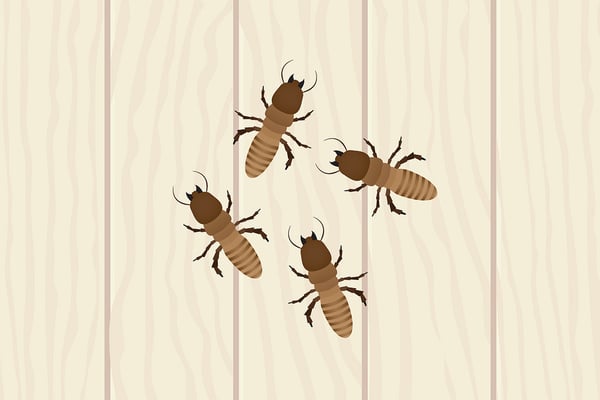It was a sunny Texas afternoon when George, a proud Texas homeowner, noticed something amiss. The wooden framework around his porch seemed to be eroding, with tiny holes and gaps appearing out of nowhere. The weight of realizing that termites might be eating away at his dream home was overwhelming. At first, George was puzzled by what he saw before he realized that he was seeing the signs of termite damage. Most Texans have the same reaction when they see the damage brought. They call their insurance agent wanting to know if their homeowners policy covers termite damage to their home. And George was no different. Maybe you have just discovered these pests in your own home. Let's take a look at what termites are, the damage that they produce, and how Ft Worth homeowners insurance policies respond to them.
What Are Termites?
Texas homeowners like George often stumble upon unwanted guests: termites. But what exactly are these tiny destroyers? Termites are insects known for their wood-eating habits, capable of causing significant damage to Texas homes. Most homeowners, unfortunately, become aware of their presence only when the damage has already been done. What does that damage look like?
Signs of Damage from Termites
Most Texans think of the termite damage from a colony "swarming out of wood". Which is understandable because of the very visible signs up a wall or from a window sill. However, a termite infestation is not always immediately visible to Texas homeowners. Other common signs include sagging floors, hollow-sounding wood, and the unmistakable presence of holes and cracks. Damage to wood isn't just aesthetic; it can compromise the structural integrity of homes. George, for instance, had noticed these tell-tale signs around his porch, making him concerned about the extent of the termite infestations in his home.
Water Damage as a Sign of Termites
It's also important to remember that not all signs of termites are directly linked to visible wood damage. Termites thrive in damp environments and often set up their nests near water sources. As a result, mold or mildew, warping of wood, and moisture stains on walls or ceilings can be indirect indicators of a termite presence. It's essential, as George learned, to address such water damage promptly, preventing further termite infestation.

Types Of Termites in Texas
There are two primary types of termites found in the state of Texas, the subterranean termite and the dampwood termite.
Subterranean Termites: These are among the most common termites in Texas. Known for their destructive nesting habits creating multiple types of damage to homes, subterranean termites can wreak havoc on your Texas home. Their behavior, especially their preference for burrowing deep into the ground and their taste for wood, makes them particularly menacing.
Dampwood Termites: Not as widespread as their subterranean counterparts, dampwood termites still pose a threat. These termites target specific types of wood and are identifiable by the smooth, clean damage they leave across the wood grain.
How Subterranean Termites Affect Structures & Treatment Plans
These termites have a unique approach. They set up vast, interconnected nests and have a voracious appetite for wood. For Texas homes, this means structural damage that can compromise the entire building's stability. Their nesting habits and feeding preferences make them a nightmare for homeowners like George. Fortunately, for homeowners in Texas, there are several treatment options available. From chemical treatments to bait stations and barrier treatments, various methods can eliminate these pests and prevent future infestations. George found solace in knowing that solutions were at hand.
How Dampwood Termites Affect Structures & Treatment Plans
Dampwood termite damage is distinct. The damage looks smooth and runs cleanly across the wood grain, different from the rougher damage of other termite species. Treating dampwood termite infestations requires a specific approach. Through tailored treatments, homeowners can effectively deal with the infestations and prevent future occurrences. Given the need to tailor these treatments in your home, the cost of termite damage can escalate beyond what you see in the structure damage.
Insurance and Coverage for Termite Damage:
Now that we've talked about the kinds of termites, the damage that they can create, and the treatment plans, we return to George's pressing question of whether or not the homeowners insurance company will provide coverage to treat and remediate the termite damage. Unfortunately, termite infestations are considered a routine maintenance issue and are generally not covered by standard homeowners insurance policies. Pest or rodent infestations also typically fall outside of standard coverage.
While we understand that this may be incredibly disappointing to hear, especially given the cost of homeowners insurance today, it is the harsh reality most Texans face. The insurance providers have been very clear on the extensive damage that termite claims produce through the years no matter your coverage limits.
Understanding Home Insurance & Preventing Termite Damage
Preventing termite damage is paramount. Regular, proper maintenance and diligent pest control are essential to keeping termite damage at bay. Since your home insurance company will likely not cover your property or personal property for termite treatment, proper maintenance is your best course of action.
While we sometimes have to bring bad news to homeowners, the independent insurance agents understand the specific needs and concerns of Texas homeowners. We are the home of True Texas Home Insurance which is tailored to provide robust coverage to Texas Homeowners.
Our dedicated team at Insurance For Texans understands the intricacies of termite damage and insurance. Our agents work for you, the proud Texans, and not for big insurance corporations. We prioritize educating Texans about their options and ensuring their homes are protected.
Click the button below if you want True Texas Home Insurance!

Ron Wadley is an owner and General Solver of Problems for Insurance For Texans. Ron is a resident of North-East Tarrant County in the Dallas-Ft Worth area. He loves riding his many bikes and watching his Baylor Bears play football and basketball. Send him your insurance questions at ron@insurancefortexans.com.



